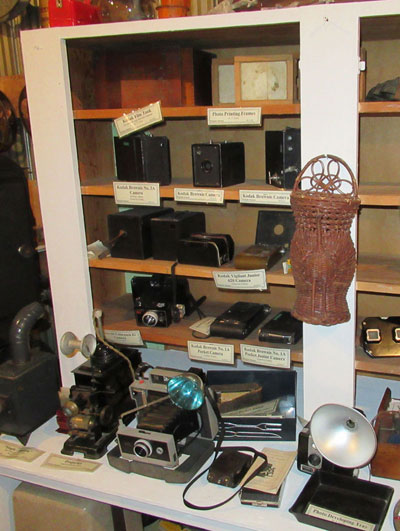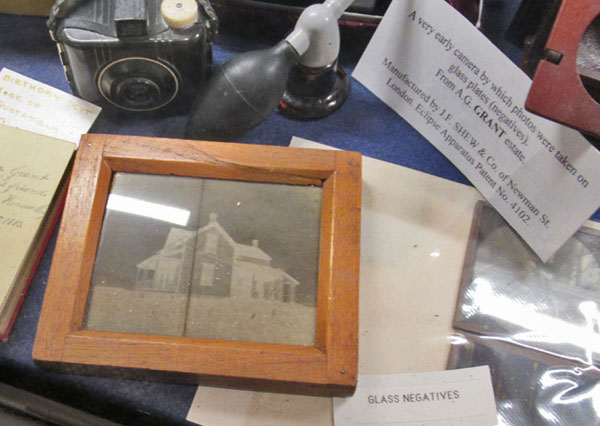
 |
Technology
|

|

The
Evolution of the Camera

A
Short History Of Photography (Adapted from Wikipeida)
In
almost 200 years, the camera developed from a plain box that took
blurry photos to the high-tech mini computers found in today's DSLRs
and smartphones.
The
First Permanent Images
Photography,
as we know it today, began in the late 1830s in France. Joseph
Nicéphore Niépce used a portable camera obscura to expose a pewter
plate coated with bitumen to light. This is the first recorded image
that did not fade quickly.
Niépce's
success led to a number of other experiments and photography progressed
very rapidly. Daguerreotypes, emulsion plates, and wet plates were
developed almost simultaneously in the mid- to late-1800s.
Niépce's
experiment led to a collaboration with Louis Daguerre. The result was
the creation of the daguerreotype, a forerunner of modern film. A
copper plate was coated with silver and exposed to iodine vapor before
it was exposed to light.
To
create the image on the plate, the early daguerreotypes had to be
exposed to light for up to 15 minutes.
The
daguerreotype was very popular until it was replaced in the late 1850s
by emulsion plates.
Emulsion
Plates
Emulsion
plates, or wet plates, were less expensive than daguerreotypes and
required only two or three seconds of exposure time. This made them
much more suited to portrait photographs, which was the most common use
of photography at the time. Many photographs from the Civil War were
produced on wet plates.
These
wet plates used an emulsion process called the Collodion process,
rather than a simple coating on the image plate. It was during this
time that bellows were added to cameras to help with focusing.
Two
common types of emulsion plates were the ambrotype and the tintype.
Ambrotypes used a glass plate instead of the copper plate of the
daguerreotypes. Tintypes used a tin plate. While these plates were much
more sensitive to light, they had to be developed quickly.
Photographers needed to have chemistry on hand and many traveled in
wagons that doubled as a darkroom.
Dry
Plates
In
the 1870s, photography took another huge leap forward. Richard Maddox
improved on a previous invention to make dry gelatine plates that were
nearly equal to wet plates in speed and quality.
These
dry plates could be stored rather than made as needed. This allowed
photographers much more freedom in taking photographs. The process also
allowed for smaller cameras that could be hand-held. As exposure times
decreased, the first camera with a mechanical shutter was developed.
Cameras
for Everyone
Photography
was only for professionals and the very rich until George Eastman
started a company called Kodak in the 1880s.
Eastman
created a flexible roll film that did not require constantly changing
the solid plates. This allowed him to develop a self-contained box
camera that held 100 film exposures. The camera had a small single lens
with no focusing adjustment.
The
consumer would take pictures and send the camera back to the factory
for the film to be developed and prints made, much like modern
disposable cameras. This was the first camera inexpensive enough for
the average person to afford.
The
film was still large. It was not until the late 1940s that 35mm film
became cheap enough for the majority of consumers to use.
Photographic
Equipment in the 1850’s
Humphrey
Lloyd Hime brought his full kit with him to document the Hind
Expedition. His camera had a two inch portrait and a two inch landscape
lens. The rest of his supplies, including chemicals, containers, etc.,
conformed to the requirements listed in Hardwich's Manual of
Photographic Chemistry, a copy of which he carried with him. This
served as a basic guide offering complete instructions on the practice
of wet plate photography.
Collodion
wet-plate photography was the process of both the portrait and
landscape photographer of the 1850s. For landscape photography it
produced some spectacular results, but required a lot of bulky and
cumbersome equipment and supplies. The portable darkroom had to be
right there, because the whole process had to be done while the
collodion was still wet. The most common portable darkroom was some
sort of collapsible tent and pole structure that could be assembled or
dismantled in a few moments and carried on a man's back with little
inconvenience.
To
use the darkroom the photographer put the top part of his body through
the opening and had the cord tied tightly around his waist while his
arms and upper part of his body remained free to move about within the
tent.
Glass
plates were used in a variety of sizes depending upon the
specifications of the camera and the lens systems employed. For field
work the supply of glass plates was normally carried in a grooved
wooden box. This box would be placed carefully close at hand near the
darkroom tent.
The
camera with its lens would be set up on a sturdy wooden tripod.
When
the plate was well cleaned and polished it was coated with the
photographic collodion emulsion which was the vehicle for retaining the
sensitive silver salts.
The
coated plate was now ready for sensitizing in the Nitrate Bath - a
combination of Silver Nitrate and cold water. The Nitrate Bath could
also be prepared in advance and stored in a bottle. However, the Bath
was sometimes a problem for the landscape photographer as it decomposed
when agitated in transit.
To
sensitize the plate the field photographer had to use his darkroom
tent. It took great care as the solution was corrosive and caused bad
staining. The plate was sensitized in the Bath for varied lengths of
time depending upon the weather - in hot temperatures thirty to forty
seconds - in cold one to five minutes. The sensitized plate was removed
from the Bath, allowed to drain and placed in a clean, dry dark slide
ready for carrying to the camera.
The
photographer gently rested the dark slide with its sensitized wet-plate
on the ground in a shaded area. He then made the final adjustments to
his camera and lens. Removing the lens cap and throwing the focusing
cloth over himself and the back of the camera, the photographer peered
through the ground glass and adjusted his focus, aperture and camera
angle. Satisfied that all was in order he inserted the dark slide with
its plate in the camera. He then made the exposure.
Exposures
for wet-plates were relatively long. For example:
thirty
seconds for a distant view with sky and water
three
minutes for a near view well lighted
six
to ten minutes for interior views
six
to ten minutes for forest scenery with light from above.
Development
as soon as possible after sensitizing and exposure was preferable.
It
was an exacting operation. The exposed plate was removed from the dark
slide. The Pyro-Gallic solution was poured evenly on the plate held in
the hand. Moving the plate to keep the solution moving, the
photographer closely watched the development for thirty to forty
seconds until the image appeared sufficiently
intense.
Knowing the exact development time was mainly a matter of experience.
The
plate could now be brought out of the darkroom tent for further
processing.
Fixing
the negative plate to render the image indestructible by light was the
next operation. The photographer poured t as substance called Hypo on
and off the plate until all the excess iodide was cleared away. The
Hypo was then washed away. This final washing was best done over a
three to four hour period, changing the water several times. Once
assured that all the Hypo was removed the plate was then placed in the
sun or some heated area to dry.
It
was an exacting operation requiring definite skill and artistry, a
goodly amount of physical stamina and energy, sufficient time, and not
a little good fortune in terms of weather, climate and environment.
https://www.thesprucecrafts.com/brief-history-of-photography-2688527
https://www.cameraheritagemuseum.com/cameras
 Local
museums feature displays
tracing the evolution of cameras.
Local
museums feature displays
tracing the evolution of cameras.
 An
example of a glass-plate negative from the Elgin Museum
An
example of a glass-plate negative from the Elgin Museum

|

|

|